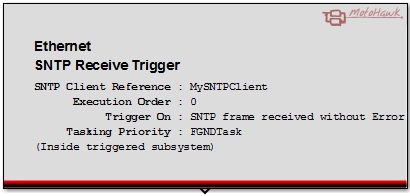MotoHawk Ethernet SNTP Receive Trigger
This block executes when an SNTP response frame has been recieved.
Block ID
Ethernet SNTP Receive Trigger
Library
motohawk_ethernet_lib
Description

This block executes when an SNTP response has been received after an SNTP Request has been sent.
Block Parameters
| Parameter Field | Values | Comments/Description |
|---|---|---|
| SNTP Client Reference | Alpha-numeric text | Reference to the Name of the Ethernet SNTP Client Definition block that this trigger refers to. |
| Trigger Name | Alpha-numeric text, single-quote enclosed | Set the text that will be appended to code generated function name. This is useful when using a difference tool to compare the difference from one build to another. If this is left as an empty cell the appended value will be generated at build time, and can change from build to build. |
| Trigger Condition |
SNTP frame received with Error or response timeout; SNTP frame received without Error; |
Selects whether this trigger executes on error or on success. |
| Execution Order within Task | Numeric (Integer) |
More than one trigger may be placed in a model that is driven by the same event.
Use the Execution Order within Task attribute to define the execution order
of these triggers relative to one another. The triggers will execute from the lowest
Execution Order within Task value to the highest. |
| This trigger is inside another triggered subsystem | Check Box (enable) | Enable if trigger is inside another triggered subsystem. Trigger attempts to simulate the block inside of another triggered rate, when the rate is periodic. The most common reason to enable is to place a background periodic task inside of a foreground periodic task, or vice versa. The trigger from this block may occur in bursts, synchronized to the outer rate, while simulating, but will perform as expected on the target. Do not enable on top-level triggers, otherwise the block will not simulate at all. |
| Trigger even when containing subsystem is disabled | Check Box (enable) | If this trigger is used inside of a containing subsystem, normally the triggered subsystem will pause and resume based on the enable/disable status of the containing subsystem. Checking this causes triggers to occur even while the parent is disabled. Note that this feature will not simulate, but will execute correctly on the target. |
| Trigger Tasking Priority |
ApplicationInteruptTask; BGNDTask; FGNDTimeTask; FGNDAngleTask |
Selects which task priority this trigger will execute in. |
| Use Standard Tasks | Check Box (enable) | Select whether this trigger will be called in the context of one of the standard tasks selected by Trigger Tasking Priority, or a user defined task specified by User Task Name. |
| User Task Name | Alpha-numeric text, quote enclosed | The name of the user defined task, that this trigger will be executed. |
